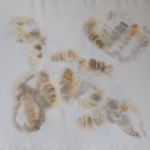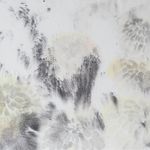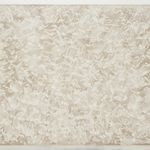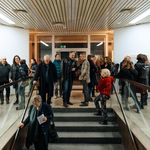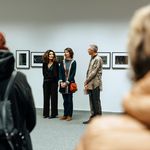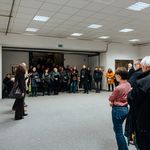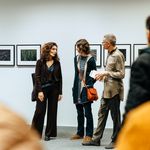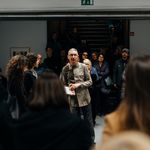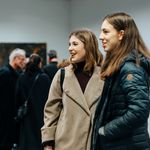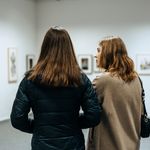Karmen Čorak and Andrej Brumen Čop / The Fragility of Being

Karmen Čorak and Andrej Brumen Čop / The Fragility of Being
UGM Studio, Trg Leona Štuklja 2
31 January – 21 March 2020
opening: Friday, 31 January 2020
curator: Andreja Borin
Andrej Brumen Čop is a well-known name on the Slovenian contemporary art scene. Karmen Čorak has established herself as a photographer mainly abroad, mostly in Italy, where she lives and works. Their long-time acquaintance, related existential sensibilities, and similarly accentuated themes of their creation have naturally led both artists to exhibit jointly—first in 2018 at the excellent exhibition venue of the Academy of Fine Arts in Rome and again in 2019 at the Museo d'Arte Moderna Ugo Cara in Muggia.
The artistic oeuvre of Andrej Brumen Čop covers several topics. Alongside the works that focus on personal themes, different imagery began to emerge in his work between 1998 and 2000. The paintings became populated by pebble stones, water surfaces, wire fences, and insects—mainly mosquitoes, ants, and flies. In the same period, the Temples series also emerged as an echo of the artist's journey to Japan. Even though its exterior seems familiar, the image takes the observer down an unknown path. It leads us towards a spiritually unfolding likeness that dwells behind the physical. As if the artist would have reached into an image, immersed himself in its essence, and imprinted in the painting what he brought to the surface. The memory of an image. The trace of an image, which he also pursues in his works on paper—in watercolours and drawings that are an equally important part of his practice. His working process often involves sticking the paper to the wall and letting it fuse with the wall. "My drawings sink into the wall," he wrote in a 2016 text entitled Kozmos. Images thus become part of the support, part of the ground, they become one with it. Monochromatically attuned tones, timelessly indeterminable backgrounds, and mottled patches create a sense of indefinable territory between the here and beyond. The images are immersed in silence and quiet anticipation. Someone or something has crossed the threshold. It might be the last time that this has glimmered in our sight or memory. It might have flared up in its true essence for the last time. This someone or something may be only a small insect or a chrysanthemum, but it is nonetheless valuable and important. Little things matter, marginal topics of the day matter, details matter. Also, because it is through the smallest things that we touch the ineffable, as only poetry can touch it. The light in the paintings and drawings of Andrej Brumen Čop acts in the capacity of the ineffable. Flies, ants, mosquitoes, and moths are travellers between worlds, clad in a monk's robe of light. Do not think that the same cannot hold true for flowers or stones.
Andrej Brumen Čop visited Japan only once, in 1996. Karmen Čorak was there at the same time, yet they did not know each other then. Čorak has remained connected to Japan to this day. She attended a photography seminar with Japanese photographer Rinko Kawauchi (2011) and also exhibited in Japan. Some of her photographs are printed on Japanese handmade paper called washi. This remarkable paper (Washi Torinoko made by Master Masao Seki on Shikoku Island) thus became an integral part of her photography, contributing to its presence and character. Karmen Čorak is an accomplished conservator-restorer, so her attitude towards this material is very specific. It is probably hard to imagine the extraordinary variety of something that ordinary people call "paper". The photographs of Karmen Čorak have many features in common with the paintings and watercolours of Andrej Brumen Čop. One of them is the handling of light—be it morning or evening light, in the shade or after the rain, which is always dimmed in her photographs. The photographs are in colour, but the colours are monochrome and muted. They glow in hushed tones ranging from deep earthy reds to translucent light and dark green, sometimes black. There is a particular delicateness to them. Red cabbage heads, a tree trunk with roots, a translucent waving fabric, or a garment of timeless age are serene witnesses to a familiar but peripheral world. Plain and solitary, yet unique and valuable. Safe in their mindful serenity, they glow like the aureoles of saints. They testify that at the heart of everything is an unknowable secret and that everything around us is more than it seems. It is impossible to know the unknowable unmediatedly. For a moment, the images of Karmen Čorak remove the veil of plainness and insignificance (which we have given them) and show the precious and fragile beauty of all that is. It disappears before our eyes, but it loses nothing. We are at loss, if we overlook it. Let me borrow the words of a 9th-century Japanese poet that encapsulate this line of thought:
The colour of this flower
Has already faded away
While in idle thoughts
My life goes by
As I watch the long rains fall.
(Ono no Komachi, ca. 833–857)
Karmen Čorak was born in 1959 in Murska Sobota and grew up in Maribor. She studied graphic design at the Faculty of Graphic Arts in Zagreb, and later focused on the conservation of works on paper and received her education in this field in Rome, Austria, and Japan. She works as a conservator-restorer at the Galleria dell'Accademia in Venice. She has been involved in photography from a young age and has been exhibiting since 2007 (Slovenia, Italy, France, Spain, Japan, Croatia, Hungary, Germany, Russia, and the US). She attended photography seminars with Japanese photographer Rinko Kawauchi (2011) and Austrian photographer Hans-Christian Schink (2017). She has received international photography awards in Paris, Malaga, and Berlin. Her photographs are included in private and public collections in Italy, France, Spain, Germany, and Japan. She lives and works in Rome and Venice.
Andrej Brumen Čop was born in 1967 in Maribor. He studied at the Academy of Fine Arts in Ljubljana. He graduated under Metka Krašovec in 1993 and completed the specialist postgraduate programme in painting in 1995. He studied in Graz (1994), travelled to Japan (1996), was awarded a scholarship by the Czech Government and studied as a visiting student at the Prague Academy of Fine Arts (1997). He received a working grant from the Slovene Ministry of Culture (2000) for a residency in New York, as well as a residency at the Slovene Studio of the Ministry of Culture in Berlin (2009). He was the editor-in-chief of the Likovne besede art magazine (2001–2002). Since 2009 he has been teaching drawing and painting at the Faculty of Education in Ljubljana, where he also runs the Gallery of the Faculty of Education or the PeF Gallery. Alongside painting, he is also working in illustration. His works have been shown at numerous exhibitions at home and abroad, and are included in several Slovenian and foreign collections. He lives and works in Ljubljana.
